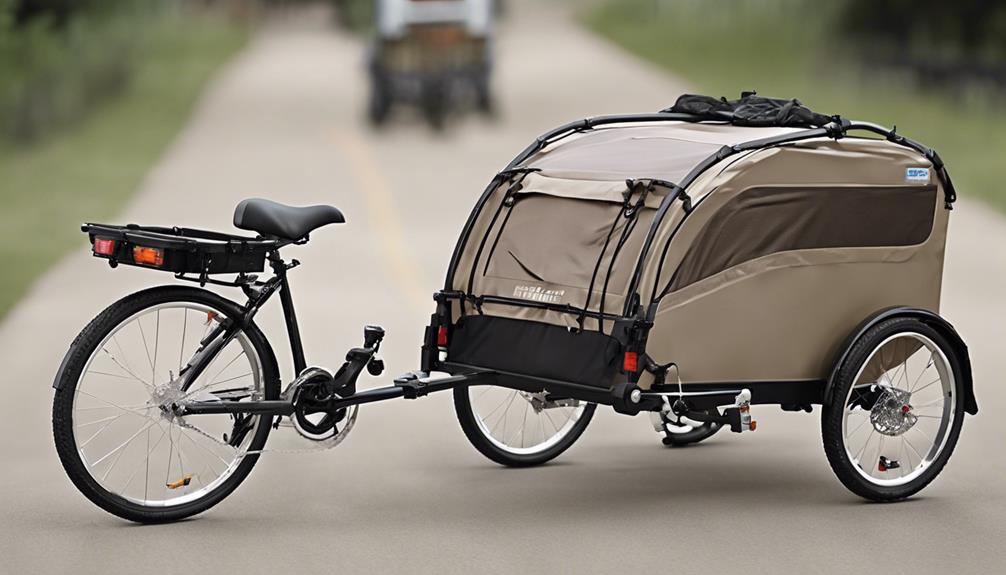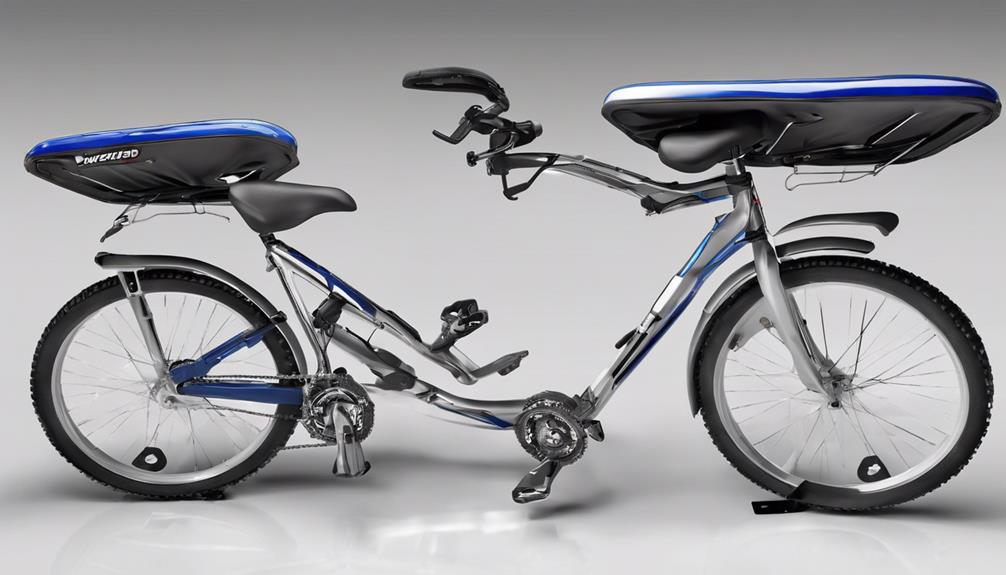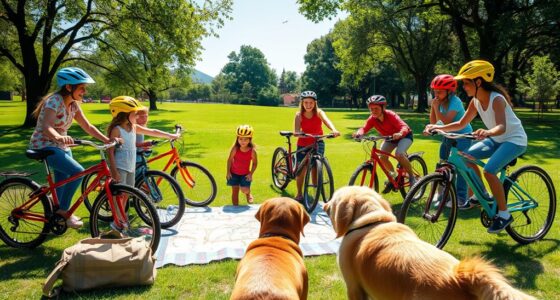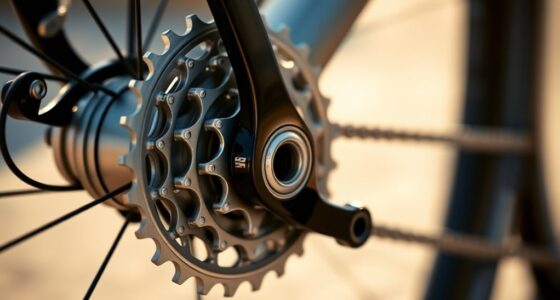When it comes to selecting the ideal bicycle trailer combinations, we know the process can be quite a puzzle to piece together. Factors such as safety, durability, and compatibility are key in making the perfect choice.
But what if there were a way to simplify this intricate decision-making process and ensure you select the most suitable option for your biking adventures?
Stay tuned to discover some expert insights on how to navigate the world of bicycle trailer combinations effortlessly and find the perfect match for your needs.
Key Takeaways
- Consider the number and age of children for suitable trailer size.
- Opt for trailers with wider seats and suspension for comfort.
- Choose trailers with weather protection features.
- Match trailer size and attachment system with your bike for compatibility.
Factors to Consider When Choosing
When selecting a bicycle trailer, it's essential to consider various factors to ensure optimal comfort and safety for your children. The type of trailer you choose should align with the number and age of your children.
For enhanced comfort during rides, look for trailers with wider seats and suspension systems, especially if you plan to venture off-road. Consider the terrain you'll be riding on; trailers with 20-inch wheels are better suited for rough terrains.
Weather protection features such as rain covers and sunshades are crucial to shield your little ones from various weather conditions. Setting a budget is important, taking into account additional features like reclining seats for added comfort and safety certifications for peace of mind.
Types of Bicycle Trailer Combinations

Bicycle trailer combinations come in various forms, including single or double trailers, as well as models that function as both a trailer and stroller or jogger. When considering the types of bicycle trailer combinations available, it's essential to keep in mind the diverse features and functionalities they offer:
- Convertible Trailers: Some trailers come with conversion kits that allow for multiple functions such as biking, strolling, jogging, or even skiing, providing versatility for different activities.
- Comfortable Ride: Trailer combinations like the Thule Chariot Cross 2 provide individual reclining seats for maximum comfort during long rides, ensuring a pleasant experience for both the rider and passengers.
- Multi-Sport Trailer: Brands like Hamax offer trailer combinations with ski harnesses, allowing families to enjoy outdoor activities year-round, making these trailers ideal for adventurous souls seeking versatility in their outdoor pursuits.
Whether you're looking to haul kids, bike cargo, or simply enjoy a leisurely ride with ample storage space, the various types of bicycle trailer combinations cater to different needs and preferences, ensuring a safe and enjoyable journey for all involved.
Top Picks for Bike Trailer Combinations

Among the top picks for bike trailer combinations, the Burley DLite X stands out for its adjustable suspension and UV protection features. This trailer offers a smooth ride with its adjustable suspension, ensuring a comfortable experience for both the riders and the person pulling the trailer. The UV protection feature is essential for long rides under the sun, providing protection from harmful rays. Additionally, the Burley DLite X comes with ample storage space, padded seats for enhanced comfort, and a mesh enclosure for ventilation and visibility.
Another excellent option is the Thule Chariot Cross Multisport Trailer, known for its smooth ride and generous storage options. If you have two kids, the Backcountry CoPilot Model A is an ideal choice with its padded seats and reflective gear for added safety. For those looking for versatility, the ClevrPlus Delux 3-in-1 Double Bicycle Stroller offers a spacious interior and a mesh enclosure for visibility. Lastly, the Burley Design Encore X is perfect for older children with its adjustable sunshade and plenty of legroom.
How to Match Trailers With Bikes

To ensure a seamless match between your bike and trailer, it's crucial to consider factors like trailer size, compatibility with your bike's attachment system, and weight capacity. Here are three key points to help you make the right choice:
- Align Trailer Size with Bike Frame: Matching the trailer size to your bike frame size is essential for proper alignment and weight distribution. This alignment ensures stability and safety while riding, especially when carrying cargo or passengers.
- Check Compatibility with Attachment System: Ensure the trailer you choose is compatible with your bike's attachment system, whether it's a quick-release skewer or another type of hitch. This compatibility guarantees a secure connection and smooth towing experience.
- Consider Weight Capacity: Before selecting a trailer, check its weight capacity to make sure it can safely accommodate the cargo or passengers you intend to carry. Exceeding the weight limit can affect the trailer's performance and compromise your safety on the road.
Selecting the Right Accessories

Considering the diverse range of accessories available for bike trailers, selecting the right ones can greatly enhance your overall biking experience in terms of convenience, safety, and functionality. To ensure you have the best bike trailer setup, prioritize accessories like rain covers and sunshades for weather protection, along with reflective elements to improve visibility, especially during low-light conditions.
Look for storage solutions that allow you to carry essentials such as snacks and toys easily accessible while on the move. When choosing accessories, consider additional features like reclining seats, adjustable suspension, and safety certifications to enhance both comfort and safety.
It's crucial to check compatibility with your specific trailer model to guarantee seamless integration and optimal functionality. Investing in high-quality accessories not only improves the overall biking experience but also ensures long-term durability and performance. By selecting the right accessories for your bike trailer, you can elevate your adventures and make the most out of your rides.
Frequently Asked Questions
What Makes a Good Bike Trailer?
We believe a good bike trailer should prioritize comfort, safety, and functionality. Quality seats with harnesses, smooth wheels, and safety features like brakes are essential. Customization options and convenient features like magnetic closures enhance the overall biking experience.
What Type of Bike Should I Get for Pulling a Trailer?
For pulling a trailer, we recommend a bike with a sturdy frame, good brakes, lower center of gravity, longer wheelbase, higher weight capacity, and appropriate gearing. These features ensure safety, stability, control, and ease of pedaling on varied terrain.
Should I Get a Single or Double Wheel Bike Trailer?
We should consider whether a single or double wheel bike trailer suits our needs. Single wheels offer maneuverability, ideal for narrow paths. Double wheels provide stability for heavier loads and longer journeys. Terrain and usage determine the best choice.
Are Bike Trailers Compatible With Any Bike?
Yes, bike trailers are compatible with a wide range of bikes. It's essential to check the trailer's hitch type for proper attachment. Some trailers have universal couplers that easily fit most bikes. Follow the manufacturer's guidelines for safe use.
Conclusion
In the world of bicycle trailer combinations, finding the perfect match is like hitting the jackpot on a sunny day ride. By considering factors like age, weight capacity, and comfort, you can ensure a smooth and enjoyable journey for you and your little ones.
With top brands like Burley and Thule offering durable options, the possibilities are endless. So gear up, hit the road, and let your adventures unfold with the perfect bike trailer combination by your side.









